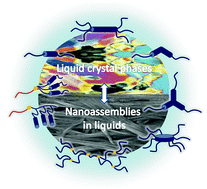Beyond liquid crystals: new research trends for mesogenic molecules in liquids
Abstract
With a view to understand the supramolecular assemblies that bring together certain molecules to form innovative functional materials with high-potential applications, the present review focuses on recent examples of molecular structures that are capable of establishing self-assemblies both in bulk and in solvents. This review demonstrates that appropriate rod- and V-shaped, disc-like and star-shaped molecules as well as high-molecular-weight compounds, either dendrimers or polymers, exhibit a dual ability. Intermolecular interactions that provide liquid crystalline order in bulk may also manifest in solution and this can lead to nanomaterials in the form of nanoaggregates. Through bottom-up approaches that involve the self-assembly of molecules driven by hydrogen bonding, π–π stacking, electrostatic or hydrophilic–hydrophobic interactions, appropriate molecules are able to induce a variety of thermotropic mesophases in bulk as well as aggregates with morphologies such as nanoparticles, nanofibers, nanorods or nanotubes in liquid media including systems in which solvents are immobilized and form gel materials. The aim of this work is to highlight the versatility of mesogenic molecules, opening the door to a wide number of possibilities, as well as to help this topic to enter into a more mature period.

- This article is part of the themed collection: Recent Review Articles


 Please wait while we load your content...
Please wait while we load your content...